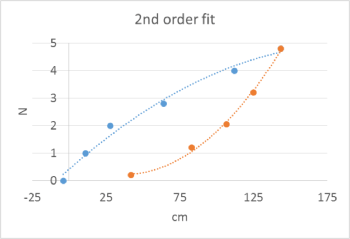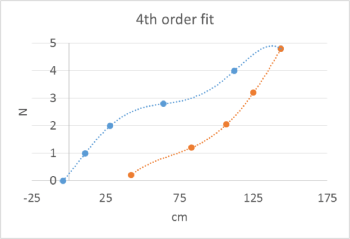Physics and Astronomy Labs/Hooke's law and Young's modulus
< Physics and Astronomy LabsThis is a simple lab that can be done in almost any school.
The hallway was used to stretch out approximately 100 ft (30 m) of string. We used an electronic force probe from Vernier Software & Technology, but an ordinary spring scale with a sensitivity of at least 0.2 Newtons could also be used. We named our device the HLA100[1]
Spring 2016 effort at WSU-Lake
Photos
-
Elastic hysteresis lab hallway wsulake.JPG
-

Elastic hysteresis lab clamping wsulake.jpg
-
Elastic hysteresis lab clamping wsulake.jpg
-
Elastic hysteresis lab rollup1 wsulake.JPG
-
Elastic hysteresis lab rollup2 wsulake.JPG
-
Elastic hysteresis lab rollup3 wsulake.JPG
Data
To measure ΔL we measured the various positions of the hook. We did not carefully measure the total length because we didn't really care. At zero Newtons, the end of the hook was at −4 cm. (see first figure below).
What rules of physics apply when you stretch a long piece of string?
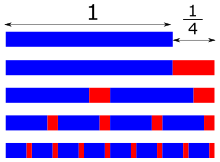
- When you pull on a piece of string, the molecules at each point along the string are being pulled apart. The force at any point in the string that holds the string together is called the tension. Your teacher will try to convince you that the tension in a low-mass string is the same all along the string.
- Is the tension the same if the string is very massive and held vertically? Explain.
- Is the tension the same if you are trying to hold back a horse and you wrap the rope around a tree a couple of times? Explain.
- If ΔL is the extra length caused by a force of 1 Newton for a string of length L, what is the extra length if we double the length, but keep the force at 1 Newton?
- Sketch the situation for a simple case with L = 3 cm and ΔL = 1 cm.
- Explain the following
<!-- If we are taliking about string from a particular type of string (area, thread-type), then if you tell me
I can tell you what the force is. This simplest law would be that they are proportional:
-->
Preliminary data on household string from the HLA100 indicates hysteresis
Force was measured as a function of strain on a string that was approximately 100ft (30.5 m) long. The diameter of the string was measured with calipers to be 0.85 ± 0.15mm, but this should be considered an estimate of the diameter because we could not accurately ascertain whether or not the caliper jaws were compressing the string. The linear density of this string is 0.512 grams/meter. It is the same string used in the paperclip drop experiment, and we performed this measurement to better understand whether longitudinal waves might cause an error in our measurement of Earth's gravitational acceleration.[2]
To check for hysteresis the first data point was taken at zero strain.[3] The string was stretched and subsequently unstretched for one cycle.
Fact-checking Wikipedia
Shown below are two graphs that have appeared on Wikipedia. One graph has an inflection point, and the other does not.
- Which graph is more consistent with the data?
- Which graph currently appears on Wikipedia:Hysteresis?
-
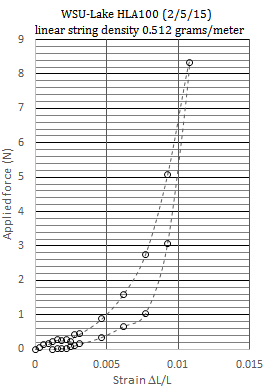
Force versus strain 0.512 gram per meter string
-
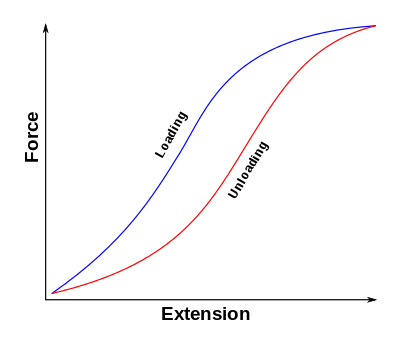
with inflection point
-
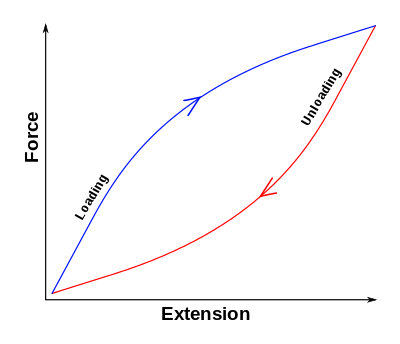
without inflection point
Raw data
The variable s is a measure of displacement, was measured from 100 ft mark, and the force, F, was measured using a Vernier force probe set to a maximum of 5 Newtons. The knot 18.7 cm from the zero foot mark did not appear to have moved.
Footnotes
- ↑ "HLA100" stands for the "100 ft Hooke's Law Apparatus". If your school is big enough you might be able to have an HLA200
- ↑ See the slinky-drop video
- ↑ I added a datapoint at 35 cm and zero force in the beginning. This is how I remember it.--[[User:Guy vandegrift|guyvan52]] ([[User talk:Guy vandegrift|discuss]] • [[Special:Contributions/Guy vandegrift|contribs]]) 17:52, 8 February 2015 (UTC)

